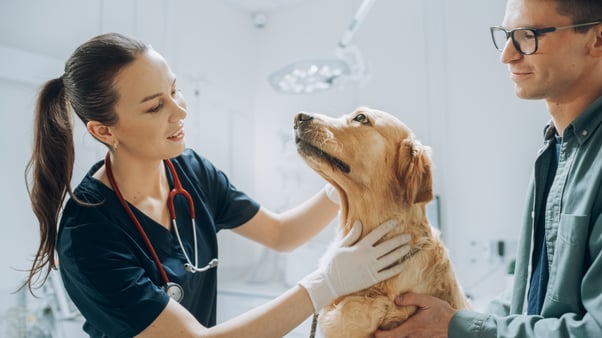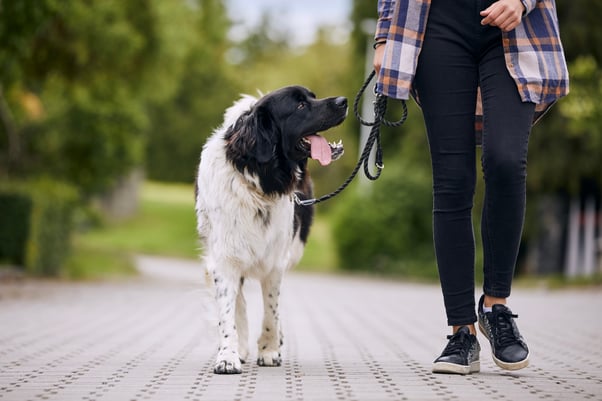Taking a dog to the vet doesn’t always have to be stressful, either for us or our dogs. The understanding of animal health care has changed significantly in recent years. Nowadays, many clinics have staff trained in low-stress handling, which aims to minimize the stress of animals visiting the clinic. However, it is not just veterinarians who can help reduce our dogs' stress; we also play a crucial role.
In today’s article, we’re exploring a few tips for taking dogs to the vet and looking at how we can help them remain calm during their visit.
Emergency Vet Visits—What to Do
First, it’s crucial to know what steps to take in case of an emergency. Not all veterinary clinics have an emergency service, but many general medical clinics are associated with a hospital for urgent cases. It’s important to discuss with your regular veterinarian about where to go if an emergency does arise, especially outside regular hours.
If you don’t have a reference hospital, you should take your dog to the nearest veterinary hospital. First, focus on ensuring your dog's safety, then call the hospital to inform them that you’re on your way and describe the situation.
Generally, you should try to make your dog as comfortable as possible and stay close for reassurance. For example, if they are in the back seat of the car, someone should ideally sit with them to help keep them calm and supported during the journey.

Taking a Dog to Scheduled Vet Appointments
Outside emergency situations, there can be several reasons why a dog may visit the vet, from regular scheduled checkups to preventative care like vaccinations.
Here are a few tips on how to calm a dog before their vet visit.
- Step 1: If your dog is healthy and not in any pain, it’s best to take a walk before the vet visit, allowing your dog to relax and sniff anything that interests them.
- Step 2: Allow enough time to walk calmly to the clinic. If the journey is long and you’re travelling by car, try to arrive early so you can take a short walk before entering. Above all, never deceive your dog into thinking they are going somewhere else.
- Step 3: Upon arrival at the vet’s clinic, inform the staff if your dog has any special requirements, such as needing to avoid having other animals nearby. If the waiting room is very crowded and a long wait is expected, it’s better to take another walk rather than stay in the waiting room.
If your dog is particularly fearful or anxious, it may be useful to ask for an appointment during a less busy time when scheduling with your vet. If your dog has trouble staying still, practise relaxation exercises at home to make it easier for them to calm down and wait quietly.
- Step 4: During the vet consultation, you should follow the instructions given by the nurses and veterinarians for handling your dog. They will often ask you to use praise and food treats to help distract your dog whilst being examined.
- Step 5: On the way home, if your dog is very stressed, take a calm walk and encourage them to sniff their environment first, before getting into the car for example. If your dog has trouble moving or is in pain, go home and let them rest in their quiet area. Avoid handling the areas where they may be in pain and give instructions to family members on how to care for them.
If you have other pets at home and your dog seems upset, avoid letting the other animals bother them. This may mean physically separating them if necessary.

Why Is It Important Not to Deceive Dogs About Their Vet Visit?
Dogs, much like us, feel more secure when they can predict events and understand what’s going to happen. They’re highly observant of our actions and their surroundings. For example, when we put on certain shoes or pack our bags, they pick up on these cues and know what will happen next. They associate one event with the next, allowing them to anticipate what’s going to occur.
This associative ability also applies when taking dogs to the vet. If they know that a particular route leads to the vet, they might resist going. If we deceive them by taking a different route, they probably won't want to go that way next time either.
To avoid this, we can try three strategies:
- Avoid deceiving your dog about where they’re going
- Make occasional visits to the veterinary clinic for reasons other than an appointment, such as picking up food or just to say hello to the team (who will be happy to help with praise and treats for your dog to make it a positive visit) without making it a negative experience
- Walk around the clinic area without necessarily going inside
This can help a dog to feel more comfortable with the environment and reduce the stress associated with vet visits.
Additional Tips for Taking Your Dog to the Vet
- If your dog is very fearful and does not handle the situation well, consult your veterinarian about using medication before visits.
- Ask the clinic team about the measures they use to help patients feel more relaxed – this could be using ADAPTIL Calm diffusers plugged in various rooms, having separate waiting rooms for dogs and cats, the use of minimal restraint when handling your dog, or requesting you to bring in treats and familiar bedding from home with you
- Work on the types of handling your dog will experience in the clinic (such as their paws being lifted, their mouth looked into etc.), so they are used to this and have positive associations with handling before their vet visit. The team at the clinic can guide you with how to practice this at home!
- Work on forced handling with the help of a professional who can guide you through the exercises and educate positively for the animal.
- Train your dog to use a muzzle. First, find a muzzle designed to allow your dog to open their mouth, take treats, and drink water. The first step is simply to show the muzzle while offering some treats. When they associate it positively, meaning they see it and become happy, start placing the treats inside the muzzle so they put their head in. The next step would be to spread a bit of soft cheese or dog pâté on the front of the muzzle for them to lick while you fasten it. Put it on for short periods so they get used to it.
- Use a calming product before you leave home. There are different choices available in the ADAPTIL range to support your dog for a vet visit. Speak to the clinic when you make your appointment for their advice on what would suit your needs best.
.png?width=1424&height=610&name=5749%20Adaptil%20full%20family%20shot%20v2%20RGB%20-%20removed%20hidden%20layers%20(33%25).png)
By following these steps, you can make your dog’s visits to the veterinarian more manageable for both them and us. Feel encouraged to practise, and if your dog still shows fear when going to the vet, contact a professional to help with a treatment plan.
Are you interested in finding more advice and information on caring for your dog from our team of experts? Don’t forget we have a huge range of articles online, plus you can sign up for our newsletter to stay up to date with all our latest tips!


.png?width=1424&height=610&name=5749%20Adaptil%20full%20family%20shot%20v2%20RGB%20-%20removed%20hidden%20layers%20(33%25).png)